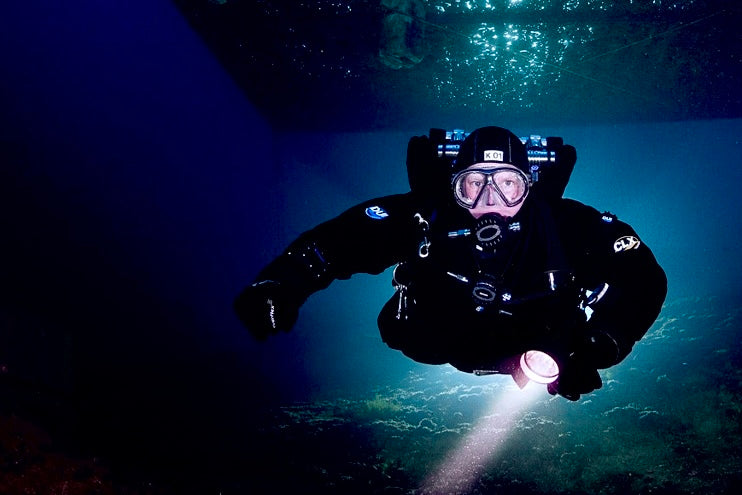
What is the difference between scuba diving and technical diving – and what equipment is needed?
Share
Scuba Diving vs. Technical Diving: The Differences
Recreational divers operate in a comfortable zone with manageable risks. The limits are depths of up to 40 meters, with simple gas mixtures such as air or nitrox and the possibility of returning safely to the surface at any time. Technical diving, on the other hand, takes you into deeper, more complex and often riskier environments that require more preparation and special equipment.
The essential characteristics of technical diving
- Greater depths and longer bottom times: Technical divers plan dives that go far beyond the limits of recreational diving, often at depths of over 40 meters and with bottom times of several hours.
- Decompression stops: Unlike scuba diving, technical divers must follow complex decompression profiles to surface safely.
- Special breathing gases: In addition to air and nitrox, exotic gas mixtures such as trimix (oxygen, nitrogen and helium) are used to minimize risks such as decompression sickness or oxygen toxicity.
- Challenging environments: Wrecks, caves and ice diving place extreme demands on planning, equipment and mental preparation.
Rebreather technology: using breathing gas efficiently
Another key element of technical diving is the use of rebreather systems. While scuba divers use open systems (open circuit), in which exhaled breathing gas escapes to the water surface as bubbles, closed or semi-closed rebreathers (CCR or SCR) recycle the breathing gas.
Rebreathers offer significant advantages:
- Efficiency: By recycling the breathing gas, consumption is significantly lower, allowing longer dives and greater depths.
- Bubble-free: This is particularly beneficial for sensitive marine life or in wrecks and caves.
- Precise gas control: The diver can precisely control the composition of the breathing gas and adjust the partial pressure of oxygen to the respective depth.
Mindset and Technique: A New Diving Mentality
Technical diving requires not only better equipment but also a new way of thinking. It is not an impulsive but a rational discipline based on careful planning, good judgement and mastery of specific techniques.
The technical diver mentality
As a technical diver, you will learn to control your emotions such as fear or uncertainty, to be more aware of your surroundings and to act rationally. You will develop an analytical approach to each dive and work with precise strategies and procedures to minimize risks.
Technical divers also focus on lifelong learning. Refining skills such as buoyancy, trim, locomotion and equipment handling becomes a constant process of improvement.
The importance of the right equipment
Equipment is what fundamentally differentiates technical divers from scuba divers. Redundancy and specialization are the keys to managing greater risks.
Tank lamps: An indispensable tool
One of the most important but often underestimated elements is lighting. A good diving lamp is not only crucial for visibility and orientation, but also a life-saving tool in critical situations. Technical lamps such as tank lamps offer:
- High light output for extreme visibility conditions,
- Focusable light beams to make details in depth visible,
- Robust constructions that remain reliable even in the event of water ingress or high pressure.
Oceanex Morph 2.0 Solitaire: The entry into professional diving lighting
The Oceanex Morph 2.0 Solitaire is the ideal choice for ambitious scuba divers who want to get familiar with professional lighting systems. It combines the performance of a technical lamp with the simplicity of a standalone system.
Special features
- Standalone system: With an integrated battery, the Morph 2.0 Solitaire works without cables or external tanks, but is upgradeable for tank light setups.
- Focusable light beam: A tightly focused spot with a soft light corona ensures optimal visibility in any environment.
- Robust and reliable: Waterproof construction and maintenance-free Hall sensor switches guarantee maximum safety.
- Made in Germany: Quality and precision from German manufacturing make the Morph 2.0 a long-term investment.
Conclusion: Technical diving for ambitious scuba divers
Technical diving is more than just a hobby - it is a fascinating challenge that allows us to grow physically and mentally. The Oceanex Morph 2.0 Solitaire offers scuba divers the perfect opportunity to venture into this world and prepare themselves optimally for future challenges.
Take the first step into a new world of diving – safe, reliable and with the right equipment at your side. Technical diving starts with Oceanex.



